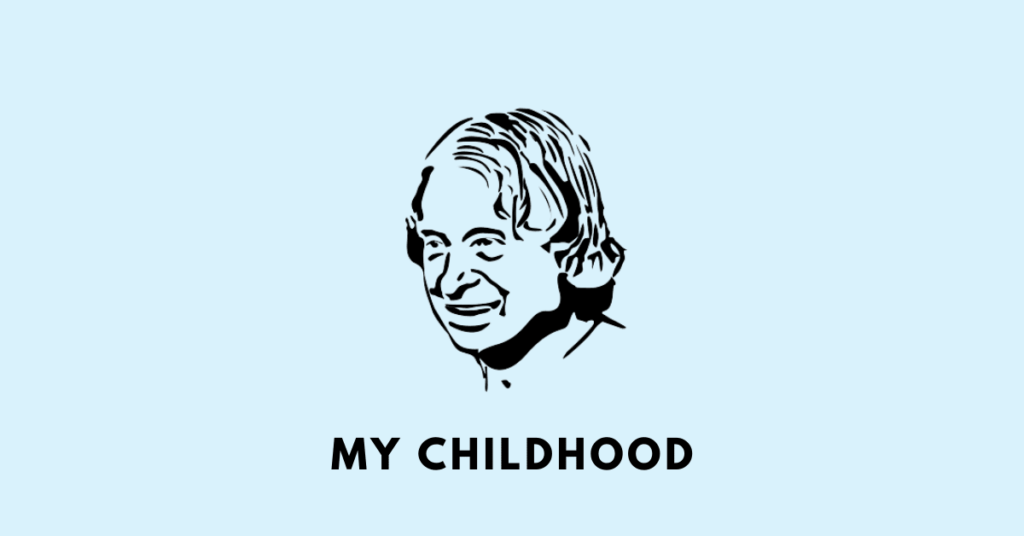My Childhood: Summary, extras, notes

Get here the summary, questions, answers, textbook solutions, extras, and pdf of the lesson My Childhood by A.P.J. Abdul Kalam of Assam Board (SEBA) and Tripura Board (TBSE) Class 9 English textbook (Beehive) and BSEM/BoSEM Class 10 English (Course Book). However, the given notes/solutions should only be used for references and should be modified/changed according to needs.
| Select your notes version |
| Summary and extras for all |
| SEBA/TBSE Class 9 notes version |
| BSEM/BoSEM class 10 notes version |
Summary
“My Childhood” is an autobiographical account written by Dr A.P.J. Abdul Kalam, one of the world’s greatest scientists. It embodies the themes of harmony and prejudice, tradition and change. Through a first-hand narrative provided by Dr Kalam, this prose highlights and gives us an idea of the life and society that existed in the southern part of India during his childhood.
Abdul Kalam was born in Rameshwaram, India, to a middle-class Muslim family. He grew up with three brothers and a sister. His father was a generous and knowledgeable man. His mother was a gracious lady. They lived on Mosque Street in their ancestral home. His father led a humble life yet supplied for his children’s needs. His parents were not well-educated or wealthy, but they were generous and compassionate. Every day, many strangers ate with the family. His parents instilled in him the values of honesty and self-discipline.
When World War II began in 1939, Kalam was only eight years old. Tamarind seeds were in high demand at the time. Abdul used to gather and sell such seeds at the market. Shamsuddin, his cousin, distributed newspapers and hired him as a helper. This is how he got his first wage. His parents instilled in him a belief in goodness and generosity.
All religions were honoured by the Kalam family. The Hindu festivities were attended by them. At bedtime, his mother and grandmother would tell the children stories from the Ramayana and the Prophet’s life. Kalam belonged to a group of three people. Ramanandha Sastry is the son of Aravindam and Sivaprakasan, a high priest at the Rameshwaram temple. They came from various religious backgrounds and were brought up in diverse ways. They were never aware of their differences. As they grew older, they pursued various occupations.
A new teacher arrived in Abdul’s fifth-grade class at Rameshwaram Elementary School. He wore a cap to distinguish himself as a Muslim. The teacher could not take a Hindu Priest’s son sitting close to a Muslim boy, therefore Kalam always sat in the front row, near Ramanandha Sastry. Kalam was requested to take a seat on the far end of the backbench. Both buddies were devastated by the situation and informed their parents after school. Ramanandha’s father contacted the instructor and warned him against instilling communal hatred and class inequity in the minds of children. He told the instructor that she had the option of apologising or leaving the school and city. The teacher expressed regret and promised to do better in the future.
Abdul was once invited to supper at the home of Abdul’s science teacher. Because he believed in religious segregation, his wife refused to serve Kalam supper in her kitchen. The teacher served him food and sat next to him to eat. From behind the closed door, his wife studied Abdul’s behaviour and found no changes. The teacher invited him back to join them the following weekend after dinner. This time, the wife prepared dinner in the kitchen herself.
After WWII ended, Kalam begged his father for permission to study in Ramanathapuram. Kalam’s father understood he needed to grow up, so he gave him permission. He advised his apprehensive wife that they should show their affection for their children but not force their opinions on them.

Additional/extra questions and answers/solutions
1. What is Abdul Kalam’s description of his home?
Answer: Abdul Kalam’s house was built in the middle of the nineteenth century, according to him. It was a fairly large pucca house made of limestone and brick and located on Rameswaram’s Mosque street.
13. What happened at Rameshwaram Elementary School when a new teacher was assigned to the class?
Answer: Ramanandha Sastry donned a sacred thread that identified him as a Brahmin, while Kalam wore a cap. When the new instructor arrived, he couldn’t stand the sight of a Hindu priest’s kid sitting next to a Muslim student. He motioned for Kalam to take a seat on the rear bench. Ramanandha was saddened by this. Abdul began sitting in the last row, but this made a negative influence on him. Both children told their parents about the occurrence. As a result, the instructor was chastised and scolded for teaching youngsters communalism and hatred.

Ron’e Dutta is a journalist, teacher, aspiring novelist, and blogger. He manages Online Free Notes and reads Victorian literature. His favourite book is Wuthering Heights by Emily Bronte and he hopes to travel the world. Get in touch with him by sending him a friend request.
Get notes of other boards, classes, and subjects